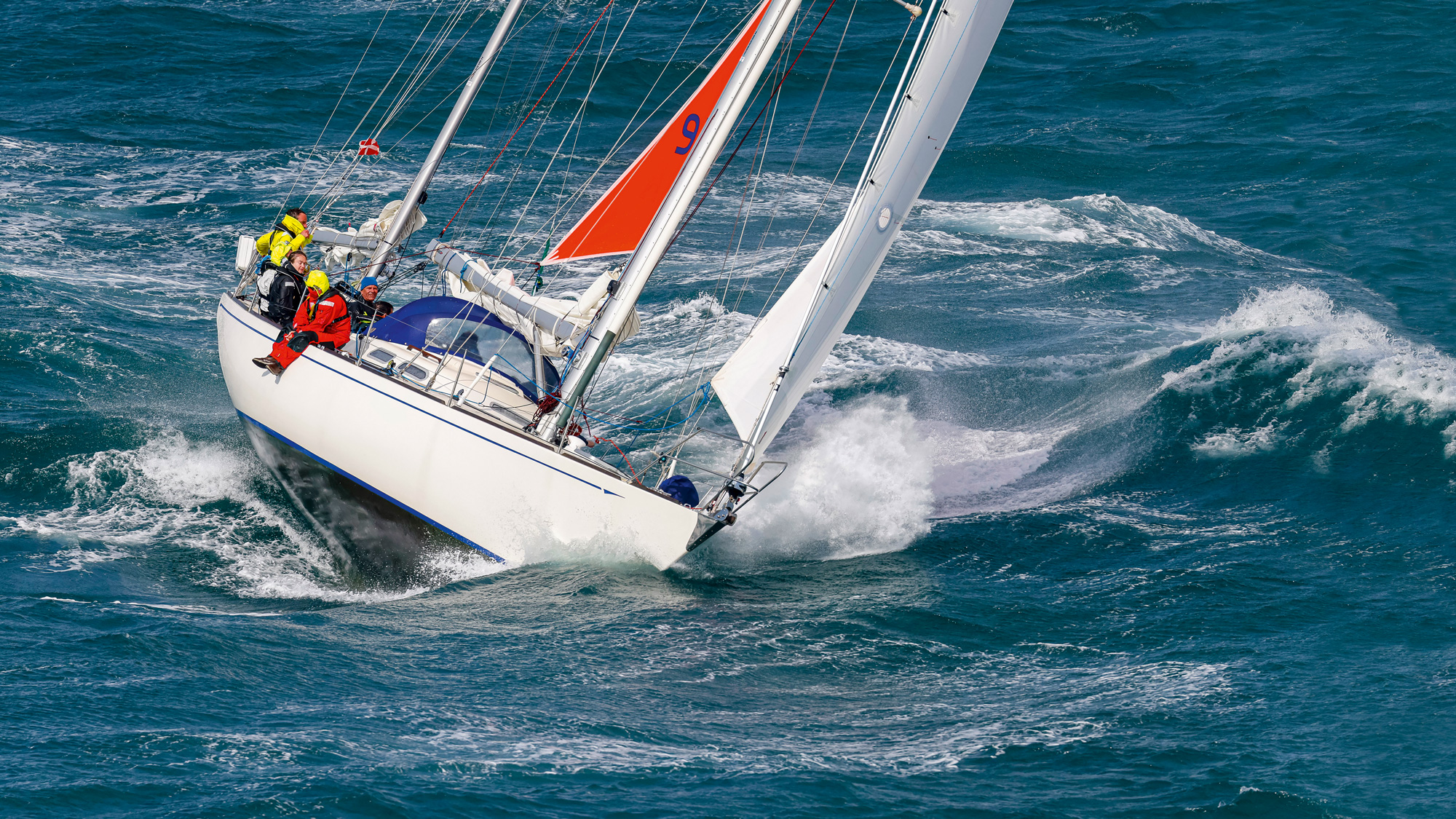Handling Storms at Sea: A Guide for Experienced Sailors
Handling Storms at Sea: A Guide for Experienced Sailors provides essential strategies and techniques for navigating rough weather conditions. From heaving-to to adjusting sails, this comprehensive guide equips sailors with the knowledge to stay safe and in control when facing storms at sea.
Whether you are a seasoned sailor or new to the open waters, this guide offers valuable insights for handling adverse weather conditions. With expert advice and practical tips, this guide is an indispensable resource for any sailor looking to enhance their storm-handling skills.
Understanding Storm Systems
Handling Storms at Sea: A Guide for Experienced Sailors offers valuable insights on how sailors can effectively navigate storm systems. From heaving-to to using sea anchors, this comprehensive guide provides essential strategies for handling rough weather conditions at sea. Discover the secrets of heavy weather sailing and ensure a safe and successful voyage.
Storms at sea can be dangerous and unpredictable, posing significant risks to sailors and their vessels. Understanding different types of storms that can occur at sea is essential for experienced sailors to navigate through these challenging conditions. Here are the key points to know:
- Hurricanes: These are tropical storms characterized by extremely strong winds that can reach speeds exceeding 74 miles per hour. Hurricanes are typically large systems that originate over warm ocean waters and can cause extensive damage.
- Tropical Storms: Similar to hurricanes, tropical storms are also characterized by strong winds and heavy rainfall. However, they have slightly lower wind speeds compared to hurricanes. Tropical storms can still pose significant risks, especially when they make landfall.
- Cyclones: Cyclones are another name for tropical storms or hurricanes, depending on the region. They are intense low-pressure systems that form over warm ocean waters, with strong rotating winds and heavy rain.
- Squalls: Squalls are sudden and short-lived storms characterized by strong winds and heavy rain. They often occur in coastal or offshore areas and can catch sailors off guard if they are not monitoring the weather closely.
- Gales: Gales are strong winds with speeds ranging between 39 and 54 miles per hour. They are common in open sea areas and can create challenging sailing conditions.
Importance Of Monitoring Weather Forecasts And Recognizing Early Warning Signs
Monitoring weather forecasts and recognizing early warning signs is crucial for experienced sailors when it comes to handling storms at sea. By staying informed about the weather conditions, sailors can make informed decisions and take necessary precautions. Here are the key reasons why monitoring weather forecasts is important:
- Safety: Knowing the weather conditions in advance allows sailors to plan their routes accordingly and avoid potentially dangerous situations. It helps to ensure the safety of both the crew and the vessel.
- Preparation: Being aware of upcoming storms enables sailors to prepare their boat for heavy weather conditions. They can secure loose items, reef sails, and take other necessary measures to minimize damage and maintain control.
- Timely Response: Early recognition of warning signs allows sailors to take prompt action, such as changing course or seeking shelter, to mitigate the impact of the storm. It provides them with valuable time to make informed decisions.
- Avoiding Surprise: Sudden storms can be highly unpredictable, and being caught off guard can be extremely risky. Monitoring weather forecasts helps sailors stay ahead of storms and avoid unexpected situations.
Key Factors To Consider When Assessing Storm Intensity And Potential Impact
Assessing storm intensity and potential impact is vital for experienced sailors to make informed decisions and remain safe at sea. Here are the key factors to consider when evaluating storm conditions:
- Wind Speed: The strength of the wind is a critical factor in determining the intensity of the storm. Higher wind speeds indicate a more severe storm with greater potential for damage.
- Wave Height: Tall and powerful waves can pose significant risks to sailors and their vessels. Monitoring wave heights helps to assess the potential impact of the storm and choose the most suitable course of action.
- Barometric Pressure: Falling barometric pressure is often an indication of an approaching storm. Monitoring changes in barometric pressure can provide valuable insights into the storm’s intensity and how it might develop.
- Rainfall: Heavy rainfall can affect visibility and make sailing more challenging. Additionally, excessive rainfall can cause flooding, potentially compromising the safety of the vessel.
- Duration: The duration of the storm is also an important factor to consider. Long-lasting storms can take a toll on both sailors and their boats, requiring adequate preparations and caution.
By considering these factors and analyzing the storm’s intensity and potential impact, experienced sailors can make informed decisions, minimize risks, and navigate through stormy conditions safely. Remember, preparation and vigilance are key when facing storms at sea.
Essential Preparations
Handling Storms at Sea: A Guide for Experienced Sailors provides essential preparations for sailors facing storms at sea. Discover expert tips on adjusting sails, reefing, and maintaining control in rough weather conditions.
The Importance Of Checking And Maintaining All Equipment Before Setting Sail:
- Inspect the rigging: Check for any signs of wear and tear, such as fraying or rust. Replace any damaged components to ensure the integrity of the rigging.
- Examine the sails: Inspect the sails for any tears or weak points. Repair or replace any damaged sections to maintain optimal sail efficiency.
- Check the navigation instruments: Ensure that all navigation instruments, such as GPS, compass, and depth sounder, are in working order. Calibrate them if necessary.
- Test the communication devices: Check the functionality of radios, satellite phones, and other communication devices. Replace batteries or faulty equipment as needed.
- Check the engine and fuel system: Inspect the engine for any leaks or mechanical issues. Clean or replace fuel filters to ensure proper fuel flow.
- Inspect the bilge pumps: Ensure that the bilge pumps are operational and free from debris. Test them to confirm their functionality in case of flooding.
- Verify the safety equipment: Check the life jackets, flares, fire extinguishers, and other safety equipment to ensure they are in good condition and readily accessible.
- Test the electrical system: Ensure that all electrical systems, including lighting and navigation lights, are working correctly. Replace any faulty wiring or bulbs.
- Inspect the hull and through-hull fittings: Check the hull for any signs of damage or cracks. Inspect through-hull fittings to ensure they’re properly sealed and functioning.
- Prepare a comprehensive checklist: Create a checklist of all equipment and systems to be inspected before each sailing trip. Use it as a reference to ensure nothing is overlooked.
Steps To Secure The Boat And Ensure It Is Storm-Ready:
- Double-check mooring lines: Ensure that mooring lines are secured properly and can withstand strong winds and waves. Use appropriate knots and additional lines if necessary.
- Reinforce cleats and chocks: Inspect all cleats and chocks for any signs of damage or weakness. Reinforce or replace them as needed to ensure they can handle the additional strain during storms.
- Secure loose items: Remove or secure any loose items on deck that can become projectiles during high winds. Stow them in lockers or lash them down securely.
- Close and secure hatches: Close and latch all hatches securely to prevent water from entering the cabin. Check for proper seals and replace any damaged gaskets.
- Check and reinforce windows: Inspect the windows and replace any cracked or loose glass. Secure them with additional covers or storm shutters to minimize the risk of damage.
- Install storm sails: If available, replace the regular sails with storm sails designed to handle high winds. Ensure they are properly rigged and ready to be deployed if needed.
- Double-check rigging and connections: Inspect the rigging and connections for any signs of looseness or wear. Tighten and secure everything to minimize the risk of rig failure during storms.
- Clear deck drains and scuppers: Remove any debris or obstructions from deck drains and scuppers to ensure proper water drainage. This helps prevent deck flooding during heavy rain or waves.
- Monitor weather forecasts: Stay updated on the latest weather forecasts and storm warnings. Prepare the boat well in advance if severe weather is expected in your area.
- Create a storm plan: Develop a comprehensive storm plan that includes actions to be taken during different storm scenarios. Share the plan with the crew and ensure everyone is familiar with their roles and responsibilities.
Emergency Supplies And Equipment To Have On Board:
- First aid kit: Ensure you have a well-stocked first aid kit that includes essential medical supplies and medications.
- Emergency signaling devices: Carry flares or other signaling devices to attract attention in case of emergencies.
- Emergency rations and water: Stock up on non-perishable food and an ample supply of fresh water to sustain the crew during an extended period at sea.
- Safety harnesses and tethers: Have safety harnesses and tethers available for everyone on board to prevent falls overboard in rough weather.
- Bilge pump backup: Consider having a backup bilge pump or manual pump in case the primary pump fails.
- Ditch bag: Prepare a “ditch bag” containing essential items like a waterproof VHF radio, emergency beacon, flashlight, whistle, and spare batteries.
- Sturdy buckets: Have sturdy buckets on board for bailing out water in case of flooding.
- EPIRB or PLB: If you’ll be sailing in remote areas, consider carrying an Emergency Position Indicating Radio Beacon (EPIRB) or Personal Locator Beacon (PLB) that can transmit distress signals to help rescue teams locate you.
- Spare lines and rigging repair tools: Carry spare lines and tools to repair rigging in case of damage.
- Fire extinguishers: Have adequate numbers of fire extinguishers and ensure they are serviced and in good working condition.
Remember, thorough preparation and regular maintenance are crucial for handling storms at sea. By following these essential steps and having the right equipment on board, you can increase your chances of safely navigating through challenging weather conditions. Stay safe and enjoy your sailing adventures!
Safety Measures
In “Handling Storms at Sea: A Guide for Experienced Sailors,” learn how to effectively navigate through rough weather conditions on the open water. Discover valuable tips and techniques to ensure safety and control in challenging situations.
Proper Crew Briefing And Communication During A Storm:
- Sailors should conduct a thorough crew briefing before setting sail, especially when rough weather is anticipated:
- Discuss the storm’s severity, potential hazards, and expected duration.
- Assign specific roles and responsibilities to each crew member.
- Review emergency procedures and the location of safety equipment.
- Establish clear communication channels using handheld radios or designated hand signals.
Implementing Strategies To Maintain Control And Stability Of The Boat:
- When sailing in stormy conditions, it’s crucial to maintain control and stability to ensure the safety of the crew and the boat:
- Reduce sail area by reefing the main and furling the headsail to decrease the boat’s exposure to wind.
- Keep the boat balanced by adjusting the sail trim, weight distribution, and centerboard or keel position.
- Steer into the wind when encountering heavy gusts or large waves to prevent broaching or capsizing.
- Maintain a vigilant lookout for changes in weather conditions and adjust your sailing strategy accordingly.
Key Safety Procedures To Follow In The Event Of A Capsize Or Crew Overboard:
- Despite taking precautions, incidents like capsizing or crew overboard may occur during stormy conditions. Sailors must be prepared to respond effectively:
- Perform a quick headcount to ensure all crew members are accounted for.
- Deploy floatation devices, such as life jackets or lifebuoys, to aid in rescue operations.
- Communicate the situation to the crew and designate specific individuals to assist in the recovery efforts.
- Execute a prompt and organized recovery plan, which may involve deploying a man-overboard module or performing a controlled capsize recovery.
Remember, safety should always be the top priority when handling storms at sea. By following proper crew briefing and communication protocols, implementing strategies to maintain control and stability, and adhering to key safety procedures in case of capsizing or crew overboard situations, experienced sailors can navigate through rough conditions with confidence and competence.
Stay safe and enjoy the thrill of sailing even in stormy weather!
Navigation And Maneuvering Techniques
Experience smooth sailing through storms at sea with this guide on navigation and maneuvering techniques. From adjusting sails to heaving-to, this comprehensive resource is a valuable tool for seasoned sailors.
Tips For Navigating Through Stormy Conditions, Including Reading Charts And Using Navigation Aids:
- Stay up to date on weather forecasts: Regularly check weather updates before heading out to sea to ensure you are aware of any potential storms or adverse conditions.
- Prepare a storm plan: Develop a detailed plan outlining your intended route, alternative options, and safe havens in case of severe weather. This will help you make informed decisions during challenging situations.
- Study charts and navigational aids: Familiarize yourself with charts, GPS systems, and other navigational aids to accurately track your position and course. This will enable you to navigate effectively even when visibility is reduced.
- Establish visual references: Identify prominent landmarks or buoys along your planned route to serve as visual references. These points can help you maintain your bearing during low visibility or stormy conditions.
- Use radar effectively: Utilize radar navigation to detect potential obstacles, other vessels, or changes in weather patterns. This can provide valuable information to avoid hazards and navigate safely.
Techniques To Navigate Around Hazards And Mitigate Potential Risks:
- Maintain situational awareness: Continuously monitor your surroundings, paying close attention to potential hazards such as rocks, reefs, or shallow areas. Regularly update your charts and adjust your course accordingly.
- Utilize depth sounders: Take advantage of depth sounders or fishfinders to measure water depth and detect underwater structures. This will help you navigate safely, avoiding shallows or submerged obstacles.
- Follow established shipping lanes: When navigating in areas with heavy vessel traffic, adhere to established shipping lanes to minimize the risk of collisions and maintain safe distances from other boats.
- Keep a lookout: Assign a crew member to maintain a dedicated lookout to alert you of any potential risks, such as other vessels, debris, or changes in sea conditions. Effective communication and vigilance are crucial in stormy weather.
- Use visual aids: Deploy visual aids such as buoys, markers, or flags to mark hazardous areas or establish temporary navigational points. These aids can assist in navigating around obstacles or navigating through unfamiliar waters.
Maneuvering The Boat Effectively In Strong Winds And Rough Seas:
- Reduce sail area: Gradually reduce the amount of sail to adjust for strong winds. This will help maintain control and stability by reducing the force on the boat.
- Use appropriate sail trim: Adjust the tension and position of the sails to optimize their performance in strong winds. Proper sail trim can enhance maneuverability and improve the boat’s ability to handle rough seas.
- Employ reefing techniques: Practice reefing techniques in advance to quickly reduce the sail area during strong winds. Reefing allows you to lessen the sail’s surface area while still maintaining propulsion.
- Play with the helm: Experiment with the position of the helm to find the most effective angle against the wind. Small adjustments can significantly impact the boat’s ability to handle strong winds and rough seas.
- Maintain boat speed: Keep the boat moving at a controlled speed to maintain steerage and prevent the boat from being pushed off course. This requires constant vigilance and adjustments to suit the prevailing conditions.
Remember, navigating through storms at sea requires skill, experience, and proper preparation. By following these tips and techniques, you can mitigate risks, maintain safety, and successfully navigate through stormy conditions. Stay informed, make sound decisions, and prioritize the safety of yourself, your crew, and your vessel.
Sail Control And Reefing
Sail Control and Reefing is a crucial aspect of handling storms at sea for experienced sailors. This guide provides valuable tips on adjusting the mainsheet, reducing sail, and maintaining control in rough weather conditions.
Importance Of Proper Sail Trim And Control In Heavy Weather:
- Maintaining proper sail trim and control is crucial when sailing in heavy weather conditions. It allows you to effectively manage the power and balance of your sails to ensure the safety and stability of your boat.
- Improper sail trim can lead to excessive heeling, increased stress on the rigging, and loss of control, making it essential to understand the importance of proper sail trim and control in heavy weather.
Steps To Reef Sails Safely And Efficiently:
- Reefing your sails is essential when facing strong winds and rough seas as it helps to reduce sail area, maintain control, and prevent overpowering the boat.
- Follow these steps to safely and efficiently reef your sails:
- Prepare the boat by securing all loose gear and ensuring the crew is wearing appropriate safety gear.
- Assess the weather conditions and decide on the appropriate reefing point based on wind strength.
- Ease the halyard tension and lower the sail to the desired reefing point.
- Secure the reefing points on the sail and re-tension the halyard.
- Trim the sails for the new reefed configuration and make any necessary adjustments to maintain control and balance.
Techniques For Depowering Sails To Maintain Control And Reduce Stress On The Rig:
- When facing heavy weather conditions, it’s crucial to depower your sails to maintain control and reduce stress on the rig.
- Here are some techniques to depower your sails effectively:
- Ease the mainsheet and/or headsail sheet to spill excess wind from the sail.
- Use traveler adjustments to control the angle of the mainsail and reduce power.
- Flatten the sails by tensioning the luff and leech lines.
- Adjust the cunningham or downhaul to bend the mast and flatten the mainsail.
- Use the backstay to tension the forestay and reduce the power of the headsail.
- By depowering your sails, you can maintain better control over your boat, reduce the risk of damage to the rig, and stay safe in heavy weather conditions.

Credit: www.virginiatkd.com
Managing Sea State And Waves
Managing sea state and waves is crucial for experienced sailors when handling storms at sea. This guide provides essential tips and techniques to effectively navigate rough weather, including adjusting sail blocks, heaving-to before reefing, and reducing sail to maintain control and safety.
Understanding The Impact Of Waves On Boat Stability And Control:
- Waves play a crucial role in determining the stability and control of a boat at sea. Here’s what you need to know:
- Large waves can have a significant impact on boat stability, causing it to roll, pitch, or yaw. This can make steering challenging and increase the risk of capsizing.
- Waves can also affect the boat’s speed and direction, potentially slowing it down or pushing it off course.
- Understanding the motion and behavior of waves is essential for maintaining control and stability while sailing in stormy conditions.
- The size, shape, and frequency of waves can vary greatly, so it’s crucial to stay vigilant and adapt your sailing techniques accordingly.
Techniques For Steering Through Waves To Minimize The Risk Of Broaching Or Pitchpoling:
- Broaching and pitchpoling are two dangerous situations that can occur when sailing through waves. However, with proper techniques, you can minimize the risk. Here’s how:
- Keeping the boat’s speed under control is crucial. Maintain a speed that allows you to navigate through the waves without losing control.
- Adjusting the sail trim can help reduce the force exerted by the waves on the boat. By depowering the sail, you can prevent the boat from being overpowered by the waves.
- Steering a zigzag course, known as ‘taking a scalloped route,’ can help you navigate through the waves at an angle, minimizing the chance of broaching or pitchpoling.
- Anticipate the movement of the waves and adjust your steering accordingly. By steering the boat perpendicular to the waves, you can prevent the boat from being pushed off course.
- Ensuring that your crew is aware of the boat’s handling characteristics and the techniques to manage wave conditions is essential for safe navigation in stormy weather.
Proper Timing And Approach To Wave Sets When Sailing In Stormy Conditions:
- Timing and approach are crucial factors when sailing in stormy conditions with multiple wave sets. Consider the following tips for a safe passage:
- Observe the wave patterns and sets in the area before making any maneuvers or changing course. Understanding how the waves are forming and breaking can help you plan your approach.
- Approach each wave set with caution, especially when dealing with larger and more powerful waves. Proper timing and execution are key to maintaining control and stability.
- Avoid crossing the path of breaking waves directly. Instead, aim to pass through the troughs between the waves to minimize the impact on the boat.
- Maintain an appropriate speed throughout the wave set. Going too fast can lead to instability, while going too slow can result in the boat being swamped or losing steerage.
- Communicate with your crew about the planned approach and ensure everyone is prepared and wearing appropriate safety gear.
Remember, sailing in stormy conditions requires experience, skill, and careful decision-making. By understanding the impact of waves, employing proper steering techniques, and timing your approach to wave sets, you can navigate safely and confidently through stormy seas. Stay vigilant, adapt to the conditions, and prioritize the safety of everyone on board.
Emergency Procedures
Experience smooth sailing during storms at sea with “Handling Storms at Sea: A Guide for Experienced Sailors. ” Learn the secrets of heavy weather sailing and discover effective techniques like heaving-to and running off to ensure your safety on the open waters.
Steps To Handle Emergency Situations
Navigating stormy seas can be treacherous, even for experienced sailors. With unpredictable conditions, it’s crucial to be prepared for emergency situations such as equipment failure or crew injuries. Here are the steps to handle such emergencies:
- Assess the situation: Take a quick but thorough assessment of the emergency situation to determine the severity and potential risks involved.
- Activate distress signal: If necessary, activate distress signals, such as a marine distress radio or flares, to alert authorities and nearby vessels of your situation.
- Ensure crew safety: Prioritize the safety of your crew members by providing first aid and immediate medical attention if someone is injured.
- Evaluate equipment failure: Identify the cause of equipment failure and try to resolve the issue if possible. If not, consider alternative solutions or backup systems to ensure the safety of the crew and vessel.
- Communicate with crew: Keep the crew well-informed about the situation and assign specific roles and tasks to maintain efficiency and coordination.
- Review emergency procedures: Regularly review and practice emergency procedures with your crew to ensure everyone knows their responsibilities and actions to take in various emergency scenarios.
- Be prepared for evacuation: In extreme cases, be prepared to abandon ship and follow the proper evacuation procedures to ensure the safety of everyone on board.
Remember, the key to handling emergency situations at sea is a cool and calculated approach. Maintaining calm and making well-informed decisions can significantly increase the chances of a successful outcome.
Communication Protocols In Case Of Distress
During emergencies at sea, effective communication is paramount. Knowing the proper communication protocols with authorities and other vessels can make a significant difference in getting the assistance and support you need. Here are some essential communication protocols to adhere to in case of distress:
- Use marine distress channels: Be familiar with the distress channels on your marine radio and use them to communicate distress signals and information about your situation.
- Follow standard distress signals: Implement internationally recognized distress signals, such as flashing SOS signals or firing red flares, to indicate that you require immediate assistance.
- Provide clear information: When communicating with authorities or nearby vessels, provide clear and concise information about your location, the nature of the emergency, and the number of crew members involved.
- Stay vigilant for response: Continuously monitor the marine radio channels and listen for any response or acknowledgement from authorities or other vessels nearby.
- Cooperate with authorities: Follow the instructions provided by authorities or rescue services and provide them with any additional information they may require to facilitate the rescue operation.
Remember, effective communication can help expedite the rescue process and increase the chances of a successful outcome during distress situations at sea.
The Importance Of Maintaining Calm And Making Calculated Decisions
When faced with emergencies at sea, it’s crucial to maintain calm and make calculated decisions. Panic and hasty actions can exacerbate the situation and put lives at risk. Here’s why maintaining calm and making calculated decisions is of utmost importance during emergencies:
- Avoid impulsive reactions: Acting impulsively can lead to hasty decisions that may worsen the situation. Taking a moment to assess the options and consider the potential consequences can help you make better choices.
- Prioritize safety: Maintaining a calm demeanor enables you to prioritize safety, ensuring the well-being of yourself, the crew, and the vessel. Clear thinking allows you to make rational decisions that minimize risks.
- Facilitate effective communication: When you remain calm, it sets a positive tone for the crew, promoting clear and efficient communication. This helps everyone work together towards resolving the emergency.
- Utilize available resources: Calmness allows you to think critically and make the most of the resources available to you. It enables you to devise innovative solutions or alternatives to address the emergency situation.
- Set an example: As an experienced sailor, your calm and composed behavior can inspire confidence in your crew. By demonstrating control, you encourage them to stay focused and follow your lead.
Remember, maintaining calm and making calculated decisions during emergencies can be the difference between a successful outcome and a disastrous one. Trust your experience and rely on effective problem-solving skills to navigate stormy seas.
Post-Storm Recovery
Recover quickly from post-storm devastation with “Handling Storms at Sea: A Guide for Experienced Sailors. ” This helpful resource provides essential tips for sailing through rough weather, ensuring safety and control on the open water.
After surviving a storm at sea, sailors must assess and address any damage or wear on their boat, clean up and maintain their vessel effectively, and prioritize self-care for the crew’s emotional and physical well-being. Here are the steps you need to take for a successful post-storm recovery:
Assessing And Addressing Any Damage Or Wear On The Boat After A Storm
- Conduct a thorough inspection of the boat to identify any visible damage or wear.
- Check the rigging, sails, and hull for any signs of structural damage.
- Look for leaks or water ingress in the deck, hatches, and cockpit.
- Note any equipment or gear that may require repair or replacement.
- Address immediate safety concerns before proceeding with cleanup and maintenance.
Steps To Take For Effective Cleanup And Maintenance
- Remove any debris or water that may have accumulated on the deck or inside the boat.
- Clean and disinfect surfaces to prevent mold growth and remove any salt residue.
- Inspect and clean the engine, fuel, and electrical systems to ensure proper functioning.
- Test all navigational equipment and repair or replace as necessary.
- Check the bilge pumps and ensure they are in working order.
- Grease and lubricate moving parts to prevent rust and corrosion.
- Keep a record of all repairs and maintenance tasks for future reference.
Self-Care For The Crew To Recover From The Emotional And Physical Toll Of The Storm
- Provide a safe and comfortable space where the crew can rest and recuperate.
- Encourage open communication and allow crew members to share their experiences.
- Offer support and understanding to those who may be experiencing anxiety or trauma.
- Provide nutritious meals and encourage proper hydration.
- Allow time for crew members to engage in activities that help them relax and de-stress, such as reading, listening to music, or practicing mindfulness.
- Organize debriefing sessions to discuss lessons learned and promote a sense of closure.
Remember, storm recovery is not just about fixing the boat but also about taking care of the crew’s well-being. Follow these steps to ensure a swift and successful recovery after a storm at sea.
Frequently Asked Questions On Handling Storms At Sea: A Guide For Experienced Sailors
How Do You Sail In Rough Weather?
Sailing in rough weather requires these tips: 1. Pinch up in a gust. 2. Push the mainsheet car downwind. 3. Slack the mainsheet. 4. Adjust headsail blocks and sheets. 5. Heave-to before sail reefing. 6. Reduce sail, slow down, and keep control.
7. Take the time to teach.
How Can I Safely Navigate Through Storms At Sea?
Navigating through storms at sea requires preparation and proper seamanship. Monitor weather conditions, stay alert, and have a plan in place. Adjust sails, reduce speed, and consider heaving-to or running off. Keep a lookout for hazards and maintain communication with nearby vessels.
What Safety Measures Should I Take During A Storm At Sea?
During a storm at sea, prioritize safety by wearing life jackets, securing loose items, and closing hatches. Keep crew members informed, maintain a steady course, and avoid unnecessary risks. Double-check safety equipment, such as lifelines, harnesses, and emergency flares.
How Do Experienced Sailors Handle Strong Winds And Rough Seas?
Experienced sailors handle strong winds and rough seas by adjusting sail trim, reefing sails, and reducing speed. Use specialized techniques like heaving-to or running off to maintain control. Stay focused, remain calm, and communicate with the crew to ensure everyone’s safety.
Conclusion
Handling storms at sea can be a daunting task, but experienced sailors know that with the right skills and knowledge, they can navigate through even the roughest conditions. In this guide, we have covered essential tips and techniques for handling storms at sea, including reefing your sails, heaving-to, and using storm anchors.
By ensuring that your boat is properly prepared and your crew is well-trained, you can increase your chances of safely weathering any storm that comes your way. Remember to stay calm, stay alert, and always prioritize safety above all else.
With practice and experience, you will become more confident in your ability to handle storms at sea. So set sail with confidence, knowing that you have the skills and knowledge to navigate through any stormy weather. Happy sailing!








